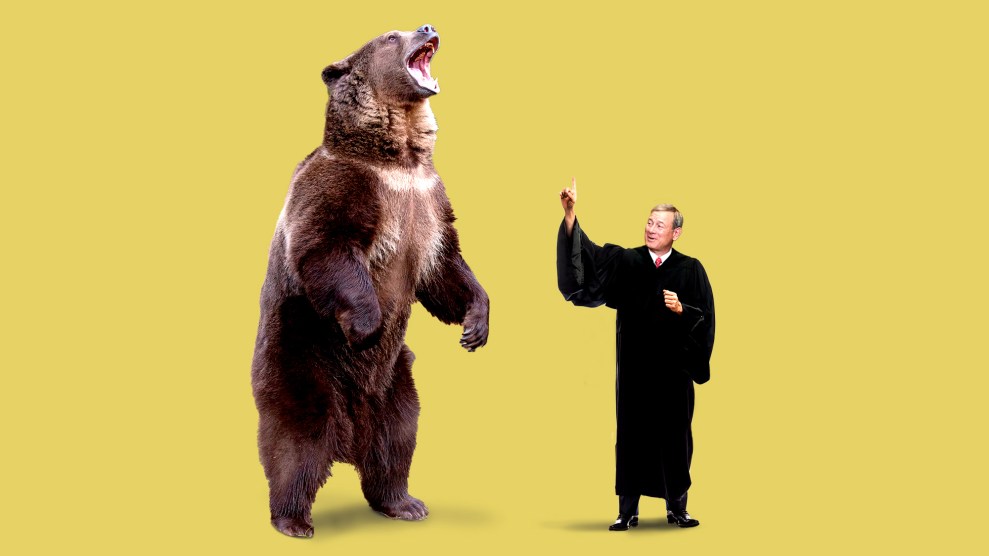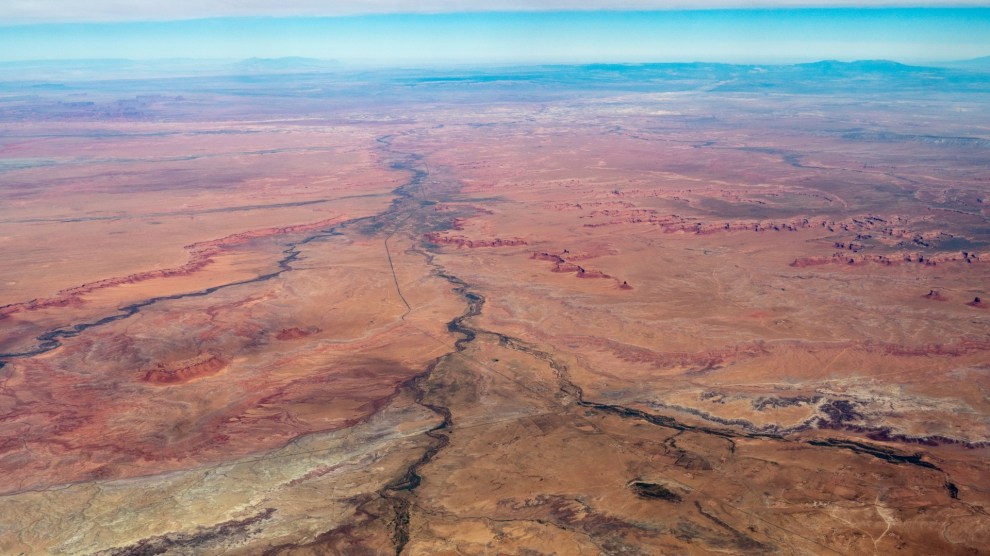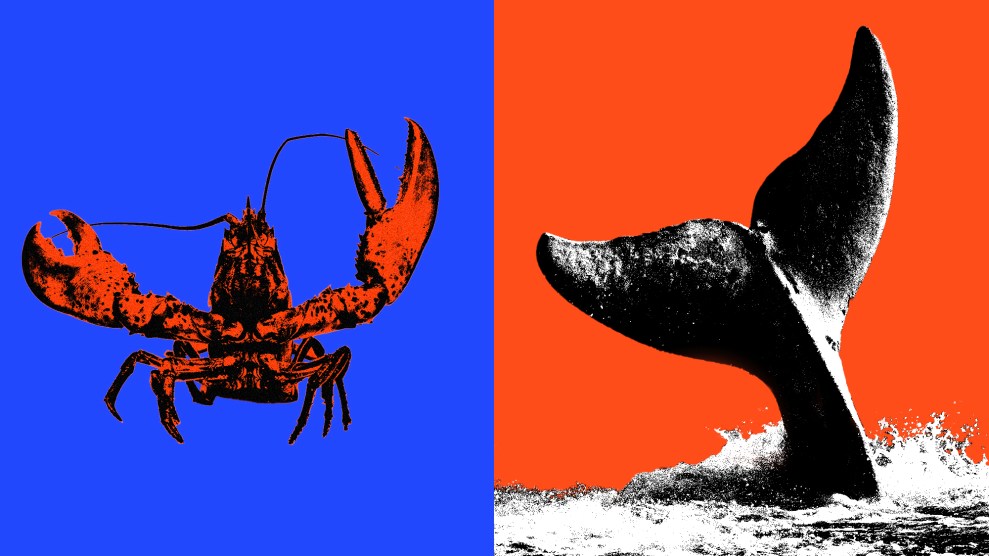
Mother Jones; Avalon/Universal Images Group/Getty, Erin Schaff/Pool/AFP/Getty
Even before the Supreme Court ruled late last month in Loper Bright Enterprises v. Raimondo, a lawsuit over a herring fishing regulation, Meredith Moore knew the case was never really about fish. Moore, the director of the fish conservation program at the nonprofit environmental group Ocean Conservancy, instead saw the case as a “Trojan horse” that would weaken public agencies’ regulatory power across the board and unleash a wave of lawsuits aimed at unraveling environmental protections. “This is an opportunity for a free-for-all,” she says.
“This is an opportunity for a free-for-all.”
As Moore had feared, when it came time for the Court to deliver its June 28 decision on Loper Bright (which it had merged with a near-identical case, Relentless, Inc. v. Department of Commerce), the conservative majority overturned a decades-old legal precedent known as “Chevron deference.” Named after a 1984 Supreme Court case involving the oil giant, the doctrine was one of the most cited legal precedents ever. For 40 years, it instructed judges to defer to an agency’s interpretation of a law—say, the Clean Water Act, Social Security Act, Affordable Care Act—when that law was unclear. Now, thanks to the pair of lawsuits (and the anti-regulatory interests like Charles Koch, who backed them), the power to determine the “best” reading of ambiguous statutes now falls to judges, not agency officials.
The decision, many legal experts warn, will curtail federal agencies’ ability to regulate everything from tax policy to reproductive rights and the environment, and is likely to be one of the court’s most significant actions in recent history—on par with decisions that overturned the right to abortion and ended affirmative action.
While it’s clear that the decision will be extraordinarily broad (which I’ve written about here and here), the specific, concrete details about its impact are less obvious. What will the ruling mean, for instance, for herring? Or other fish we eat? Or any of the more than 1,000 threatened and endangered species in the US?
Let’s start with herring. The regulation that sparked Relentless and Loper Bright required herring fishermen to pay for boat observers to monitor their catches—around $700 per trip—a practice intended to document what species are caught and prevent overfishing under the Magnuson–Stevens Act. While the Supreme Court took up the case, it only agreed to address Chevron deference, putting the fate of the fishing regulation in the hands of lower courts.
But beyond that single rule, Moore worries about federal efforts to manage fisheries in all sorts of other ways. Under the Magnuson–Stevens Act, the primary law governing US fisheries, she explains, the National Oceanic and Atmospheric Administration (NOAA) sets catch limits for various types of fish. If a population becomes overfished, the agency creates plans to rebuild them. In the last nearly 25 years, the agency says it’s helped recover 50 fish stocks, including populations of bocaccio (a type of rockfish), Snohomish coho salmon, and Pacific Ocean perch. But now, if the agency’s regulations are challenged in court, it will be up to a judge, rather than NOAA officials, to identify the most suitable application of laws like the Magnuson–Stevens Act—a change Moore worries will make it harder for NOAA to keep US fisheries operating sustainably.
Many other regulations may also be at risk. According to Democracy Forward, a nonprofit public policy research organization tracking lower-court citations of Loper Bright and Relentless, there have been at least 40 references to the court’s Chevron ruling as of mid-July, including in filings in 19 different cases and opinions from 11 courts. These citations involve many areas of the law, from gas appliance energy standards, Title IX, abortion, airline fees, anti-discrimination provisions in health care, and more. “By and large, these cases are being used aggressively to seek to stop regulations and programs that benefit the American people,” said Skye Perryman, the president and CEO of Democracy Forward. In one lawsuit, Massachusetts Lobstermen Association v. National Marine Fisheries Service, lawyers representing lobster fishermen referenced the Supreme Court’s Chevron ruling as part of their fight against a federal regulation intended to protect North Atlantic right whales. (Read more about this battle here.)
But not every environmental advocate sees the overturning of Chevron deference as a disaster for plants and animals. Brett Hartl, the government affairs director at the Center for Biological Diversity, an environmental group that has sued the federal government many times for not doing enough to protect imperiled wildlife, told me that he expects the decision to yield a “mixed bag” of lawsuits that will take years to play out. But he also sees it as an opportunity to strengthen certain environmental protections.
For instance, Hartl argues, the Fish and Wildlife Service hasn’t always gone far enough to protect at-risk species as required by the Endangered Species Act. The agency has failed to follow its own species recovery plans, he argues, often proposing to delist species too soon. And it has never fully grappled with a key definition in the ESA: what it means for a species to be at risk of extinction within “a significant portion” of its “range”—whether that means an animal’s current range, historic range, or something else. The agency’s “unambitious” and “piecemeal” approach to recovery, as the Center for Biological Diversity has described it, hurts creatures like wolves and grizzly bears that once roamed large swaths of the country. (When reached by email, a spokesperson with the Fish and Wildlife Service pointed me to the Department of Interior, which declined to comment on its alleged shortcomings or the impacts of overturning Chevron broadly.)
Similarly, the wording of the National Environmental Policy Act, or NEPA, Hartl points out, suggests a need to steward the environment for “succeeding generations.” With this language, he argues, “NEPA creates almost an intergenerational responsibility to the environment,” and no administration has ever really capitalized on that mandate. Now, without Chevron, he argues, a federal judge might agree that federal agencies ought to do more to protect the environment under the law.
“If you have agencies constantly not meeting their mandates, and sort of falling short,” Hartl says, “Chevron is mostly a shield for them that has allowed them to perpetuate bad behavior.”
Now that Chevron is gone, Hartl says, “there actually are opportunities to make things better.” (The Center for Biological Diversity, he told me, is already planning to “retool” some of its ongoing lawsuits and introduce new ones to take advantage of the ruling.) Hartl argues that if Donald Trump wins reelection, his agencies will have “a hell of a lot less power” when it comes to regulations. “Do you want them having all this deference? I don’t.”
But overall, most of the experts I’ve spoken to about Chevron deference did not see a silver lining for wild plants and animals (or for environmental protections as a whole). Holly Doremus, an environmental law professor at UC Berkeley School of Law, told me via email that an optimistic view like the Center for Biological Diversity’s may be trying to “see the best in a bad situation.” In the short run, she expects federal courts to follow the Supreme Court’s lead and “be much more skeptical” of agency actions they see as overstepping the law rather than those seen as not going far enough for, say, endangered species protection. As Vermont Law School emeritus professor Pat Parenteau explains, lower courts often take their cues from the Supreme Court, which has signaled a clear desire to narrow environmental laws and reign in agency authority.
Lower courts often take their cues from the Supreme Court, which has signaled a clear desire to narrow environmental laws and reign in agency authority.
Other experts noted that the loss of Chevron will likely prompt groups on all sides of the political spectrum to judge-shop in specific courts to challenge rules they dislike. This could lead to a “lack of coherence” in which agency regulations are overturned or upheld, NRDC lawyer David Doniger, who argued the original 1984 Chevron case before the Supreme Court, told me ahead of the recent ruling. (It’s no secret, for instance, that a disproportionate number of lawsuits against Biden administration regulations are filed in the Amarillo Division of the US District Court for the Northern District of Texas, where conservative, Trump-appointed Judge Matthew Kacsmaryk sits.)
“I think you could have maybe a few wins here and there,” the Ocean Conservancy’s Moore says. “But I’m more concerned about the instability, uncertainty, and patchwork nature of what regulations will look like if they’re all able to be sued in different ways in different places.”
Echoing both Moore and Doremus, Parenteau said that while environmental advocates may see some victories in court, he believes they’re up against a “stacked deck” under this new system, in part because of the signals coming from the Supreme Court and industry’s near-unlimited resources to sue the government.
“The opponents of environmental regulation have the upper hand, there is no question about it,” he says.” And they’re going to win and win and win. And environmental advocates are just going to have to scrape and claw and try to win a few. That’s the world we’re in.”


















